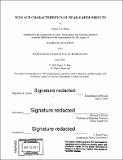Surface characteristics of near-earth objects
Author(s)
Hsia, Nancy P
DownloadFull printable version (3.131Mb)
Other Contributors
Massachusetts Institute of Technology. Department of Physics.
Advisor
Richard P. Binzel.
Terms of use
Metadata
Show full item recordAbstract
Asteroids are thought to be the source of all meteorites found on Earth. Numerous spectroscopic studies have been performed to try and link certain types of meteorites with certain classes of asteroids in space. However, these spectroscopic studies of meteorites and asteroids have often shown a discrepancy between the meteorite and asteroid spectra, with the asteroid spectra showing a higher red slope and less prominent absorption bands. This effect has been seen especially in the spectra of asteroids located in the main belt. Scientists now believe that space weathering processes, such as solar wind ion implantation and bombardment by micrometeorites, can affect the upper few millimeters of an asteroid's surface to produce the higher red slope and reduced absorption bands seen in spectra. However, asteroids in the near- Earth region, which are generally smaller than those found in the main belt, have not shown signs of space weathering as much as asteroids in the main belt. The purpose of this study was to investigate factors that might influence the appearance of near-Earth asteroid spectra, in particular the conditions at the time of observation. The two main observational conditions examined were the apparent magnitude of the object, or V-magnitude, and the angle between the Earth, object, and Sun, commonly called the Phase Angle. Running-box average plots and least-squares analysis was performed on a data set of 332 near-Earth asteroids to determine if any links could be made between the spectral characteristics and observational parameters. The most interesting finding of this study was a correlation in the SQ-complexes between the second spectral component, PC2', which indicates the presence or absence of an absorption band at 1 [mu]m, and the Phase Angle for the SQ-complex asteroids, suggesting that the observation angle affects the spectrum of an asteroid. One possible explanation may lie in the fact that the particle size of the asteroid surface must be much larger than the wavelength of the light to create the multiple scattering needed to reflect light in the direction of the Earth.
Description
Thesis: S.B., Massachusetts Institute of Technology, Department of Physics, 2003. Cataloged from PDF version of thesis. Includes bibliographical references (pages 32-33).
Date issued
2003Department
Massachusetts Institute of Technology. Department of PhysicsPublisher
Massachusetts Institute of Technology
Keywords
Physics.